Throughout history, the relationship between high-ranking prisoners and their captors used to be relatively close and, at times, even affable. To cite just a few nearby examples, except for the first tense moments, Moctezuma and Atahualpa even made good friends with some Spaniards; something similar can be said of Francisco I, well treated during his stay in Madrid, or of the family of Carlos IV in Bayonne and Valençay. All of them had a famous precedent, perhaps even inspiring, in the captivity of the family of Darius III at the hands of Alexander the Great and especially the queen mother, Sisigambis.
Darius III was King of Persia for eight years, between 338 and 330 BC. He had inherited the throne of Artaxerxes IV, also known in Greek as Arsés, of whom he was not a son but rather a distant relative. Arsés had been poisoned by the vizier Bagoas, a eunuch of enormous power who had already assassinated the previous monarch, Artaxerxes III, seeing that the successor was not as manageable as he expected and was receptive to those who demanded his dismissal (or something worse). of the vizier, very unpopular for not having blue blood.
Bagoas therefore removed Arses and appointed in his place a young royal courier, Darius, nephew of Artaxerxes II. His father, Ostanes, brother of the aforementioned, had married his daughter, Sisigambis, whom some sources consider to be the daughter of Ostanes (for which she would have taken her own brother as her husband, something that was not unusual in the Persian royal tradition) and others of some Uxian leader (the Uxii were a confederation of semi-nomadic non-Iranian tribes that inhabited the surroundings of the Zagros mountain range, which runs from Iraqi Kurdistan to the Strait of Hormuz).
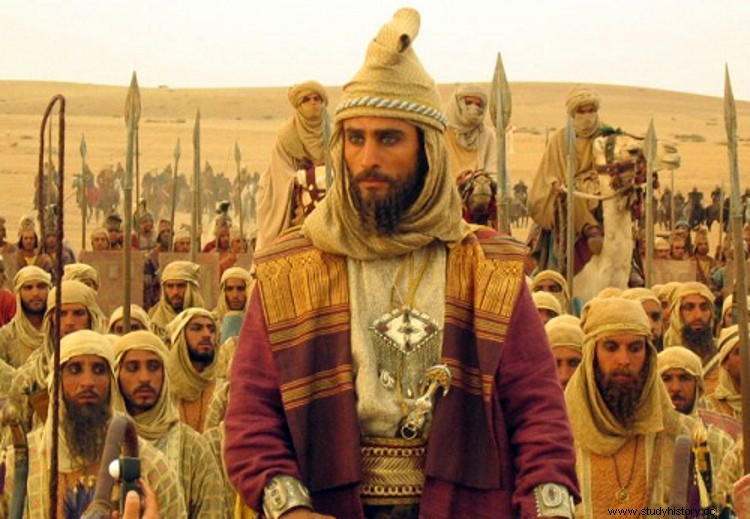
In any case Sisigambis gave birth to three offspring:Darius around 380 BC, Oxatres five years later and possibly Statira (her date of birth is unknown). The eldest son turned out to be as unmanageable as his predecessor, to the disappointment of Bagoas. But this time the scheming vizier failed in another attempt at regicide and ended up executed. Thus began the reign of what would be the last sovereign of the Achaemenid dynasty; last because, to his misfortune, he had to share time with another young man, in this case a Macedonian, who considered that there was not enough room in the world for both of them.
His name was Alexander and, following the policy of his father Filipo, he had unified all the polis Greek under his person as hegemon . Then he had embarked on the conquest of Persia to avenge the offense committed long ago by Darius I and Xerxes I by trying to invade Greece on two occasions and incidentally liberate the cities of Hellenic culture that were in Ionia, Asia Minor, subjected to the Persians:Ephesus, Halicarnassus, Pergamon, Miletus…
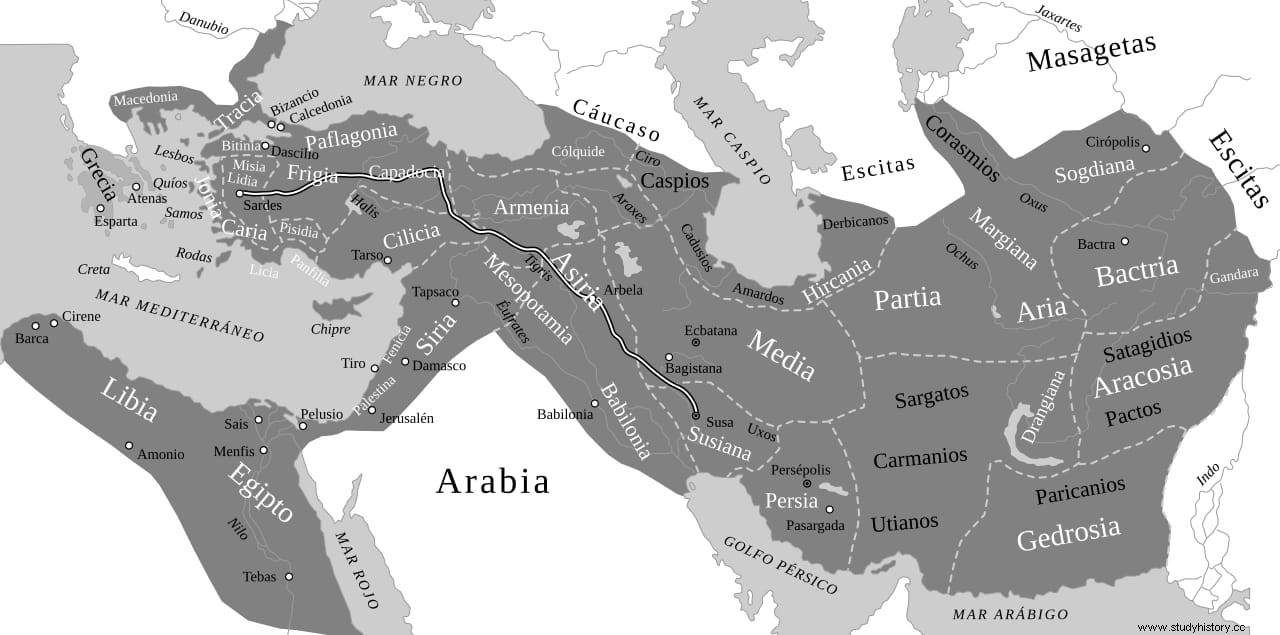
At the head of his phalanx, Alexander was advancing through the heart of the enemy empire without anyone being able to stop him, prevailing one after another in as many battles as he faced. He began by defeating Mennon's mercenaries at the Granicus River and continued marching through Cilicia towards Syria, after passing through the city of Gordio to undo the famous knot that augured his bright future. However, the news that Darius III had annihilated a camp of wounded Macedonians infuriated him and he turned to face him.
The clash occurred at Issos, present-day Turkey, in November 333 BC. The Greco-Macedonian army numbered only about 40,000 men compared to the tremendous size of the Persian, which was around 100,000. Darío himself directed it from a car, but that volume of soldiers was counterproductive when it came to moving effectively because the battlefield was too narrow. Thus, the Macedonian cavalry charged suddenly on the left flank penetrating like a knife and the Persians did not know how to take advantage of the gap they left. Alexander realized the risk and in a show of audacity, instead of backing down, he ordered to attack the other flank.
That sowed chaos in the enemy ranks and when Darío tried to reorganize them, Alejandró advanced towards the center with the phalanxes. The Persians broke what little was left of his formation and it became an all-for-all when they saw the king himself turn the chariot and run away from him. It is estimated that the disaster caused 20,000 deaths and even Darius was about to perish at the hands of the cavalry with Alexander at the head:according to Diodorus of Sicily, he was only saved by the heroic personal intervention of his brother Oxatres at the head of a small escort, interposing in the middle.
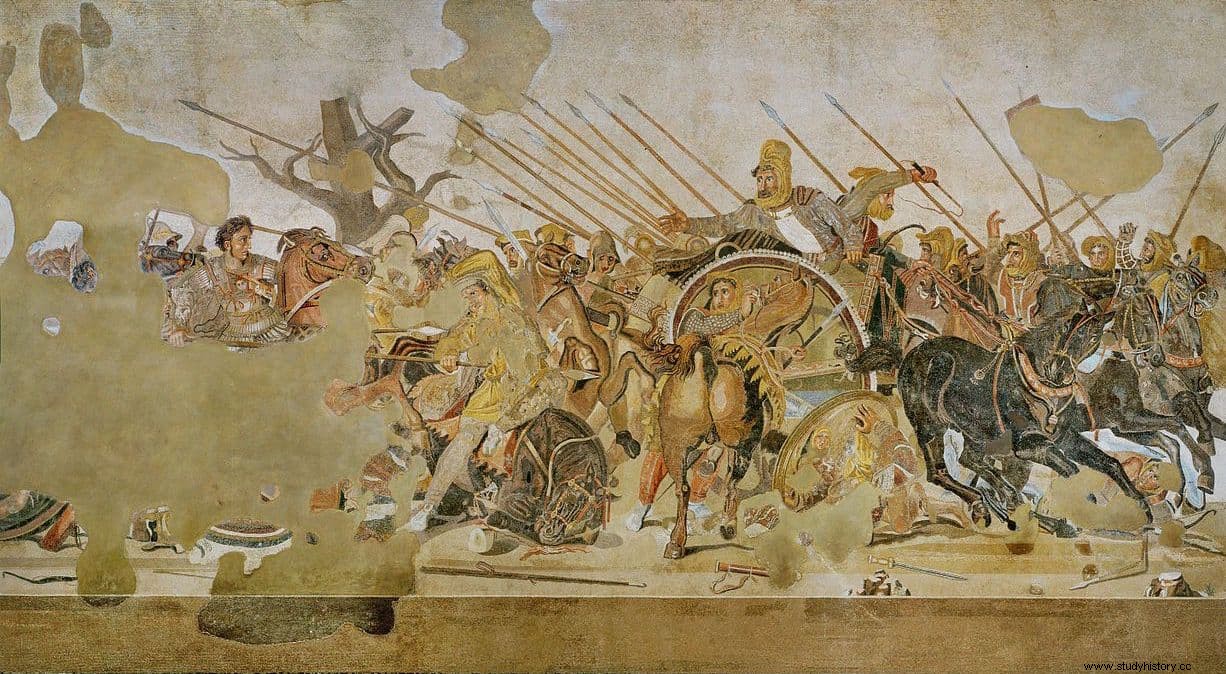
That gesture, represented in the famous Pompeii mosaic, made Oxatres fall prisoner but allowed the monarch to escape. Of course, the rest of the royal family was also captive:his mother Sisigambis, his wife Estatira, his daughters Barsine (the historian Lucio Flavio Arriano refers to her by this name but in reality her name was Estatira, like her mother, although we are going to name her that way so we don't get confused) and Dripetis, and their little son Oco (he was six years old).
Legend has it that, at the end of the fight, Alexander and his friend Hephaestion went to visit their illustrious prisoners, finding that Sisigambis threw himself at the feet of the second, mistakenly taking him for Alexander and begging for the lives of his own. Apparently, the confusion was due to a matter of physical appearance:apart from dressing alike, Hephaestion was taller than his boss and therefore made a greater impression. When her mistake was cleared up, she felt very ashamed, but Alejandro calmed her down with one of those phrases as improbable as they are memorable: «You were not wrong, mother; this man is also Alexander.”
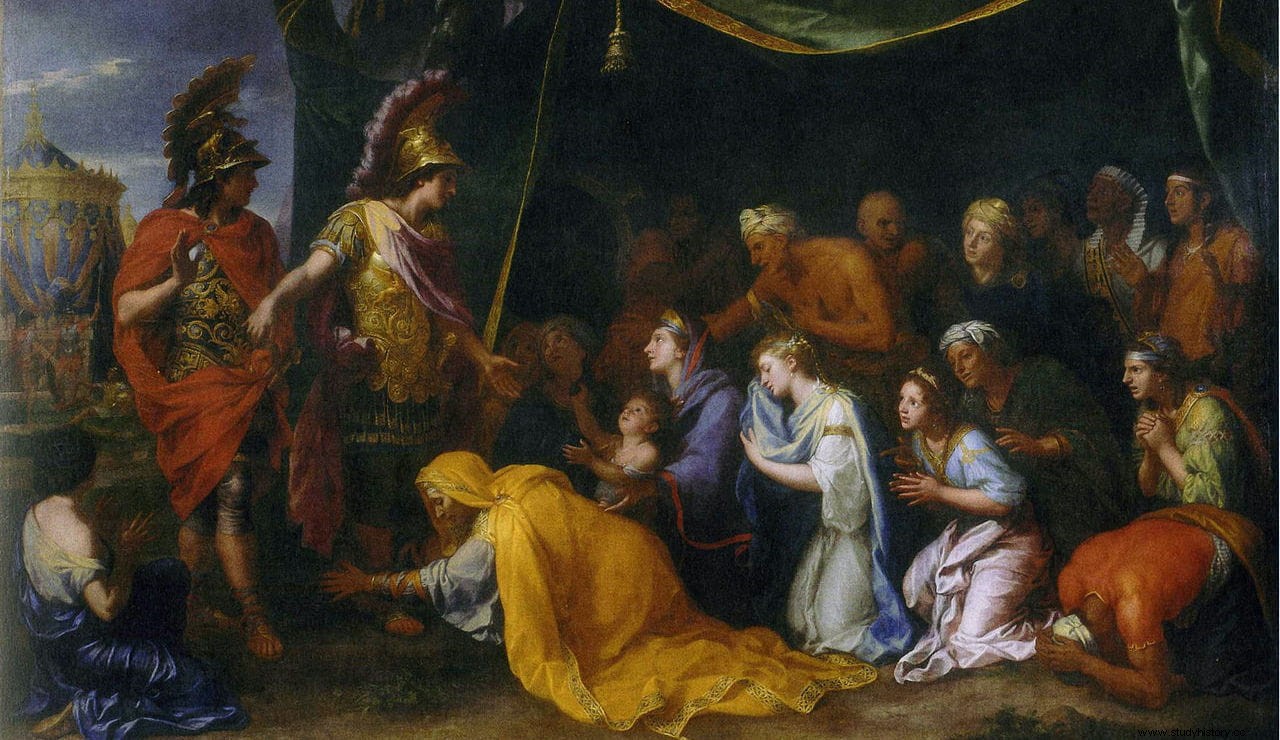
Sisigambis and her relatives were, indeed, well treated and that moved her to the point of not only losing that initial fear of her captor but admiring him. The deal did not change even when Darius III, whose attempts to pay for his release failed, returned to battle at Gaugamela two years later. That time there was a paradoxical reverse situation:the King's relatives were in the Macedonian rearguard, attending the new duel between the two most powerful men in the world.
In fact, during the combat, a unit of Scythian cavalry entered the enemy camp with the mission of rescuing the royal family, but their commanders were greatly surprised to see that the queen mother refused to accompany them, since she did not want to betray the noble deference that Alexander had shown to his people. Then, General Parmenio, who was in command of the auxiliary phalanxes, counterattacked and put the raiders to flight, who joined the general rout of their own.
Because, once again, Alexander's tactical genius prevailed, causing another Persian debacle, despite the fact that the disproportion of forces was even greater than at Issos:barely 47,000 warriors to face a quarter of a million adversaries. Gaugamela ended with tens of thousands of dead Persians and the monarch fleeing in his chariot, only now the Heitaroi came out in pursuit of him of Alexander, the elite cavalry, to settle the matter definitively. However, Darío slipped away again thanks to the arrival of the night.
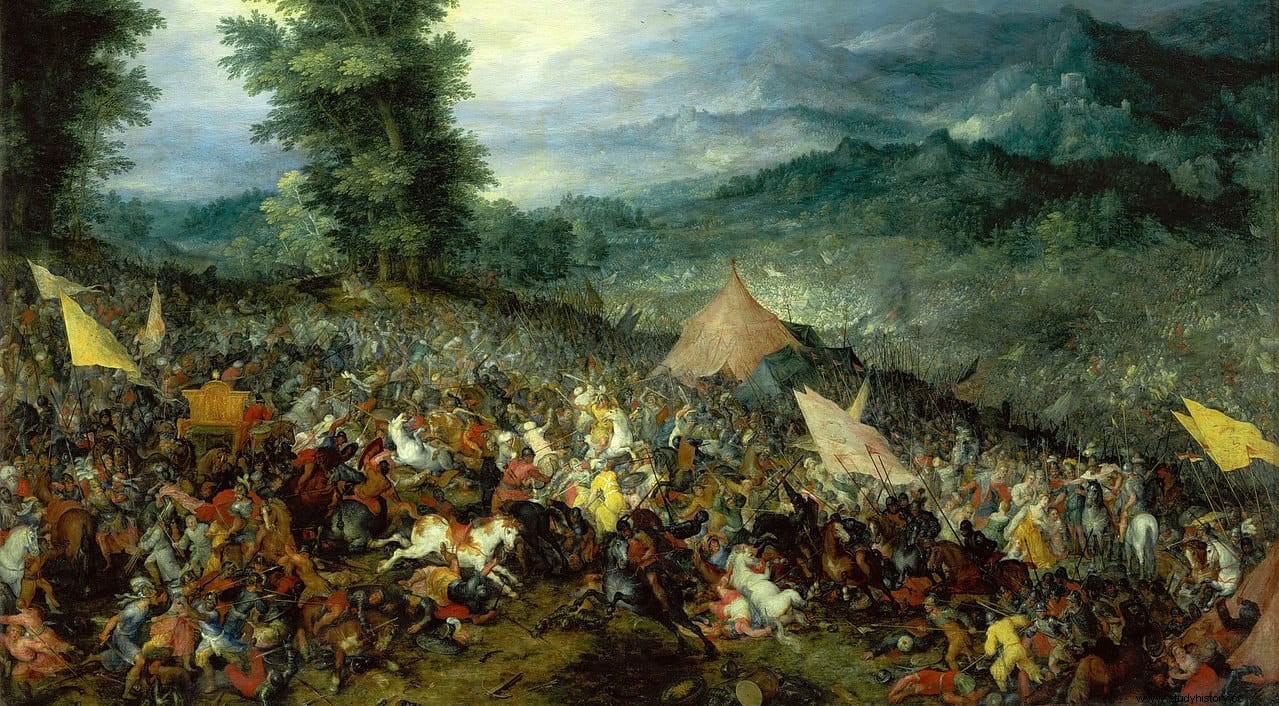
But not for long. He took refuge in Ecbatana, the capital of Media, while his opponent conquered Babylon and Susa before resuming the pursuit, forcing him to flee to Bactra. There, the King was betrayed by several nobles and satraps who killed him believing that the Macedonian would stop his advance, something in which they were wrong. Moreover, Alejandro was sorry and ordered not only to organize a state funeral for the deceased but to arrest his murderers and hand them over to Oxatres.
Oxatres was also treated kindly by Alejandro and was dazzled by the Macedonian's magnetic personality, so he joined the Heitaroi, becoming his bodyguard. The murderers of his brother were given the usual treatment applied in the Persian Empire to crimes of this type:they were first mutilated by cutting off their ears and noses and then crucifying them. But the most terrible thing for the prisoners was knowing that their bodies would not be deposited in columns to feed the vultures, as Zoroatrism commanded.
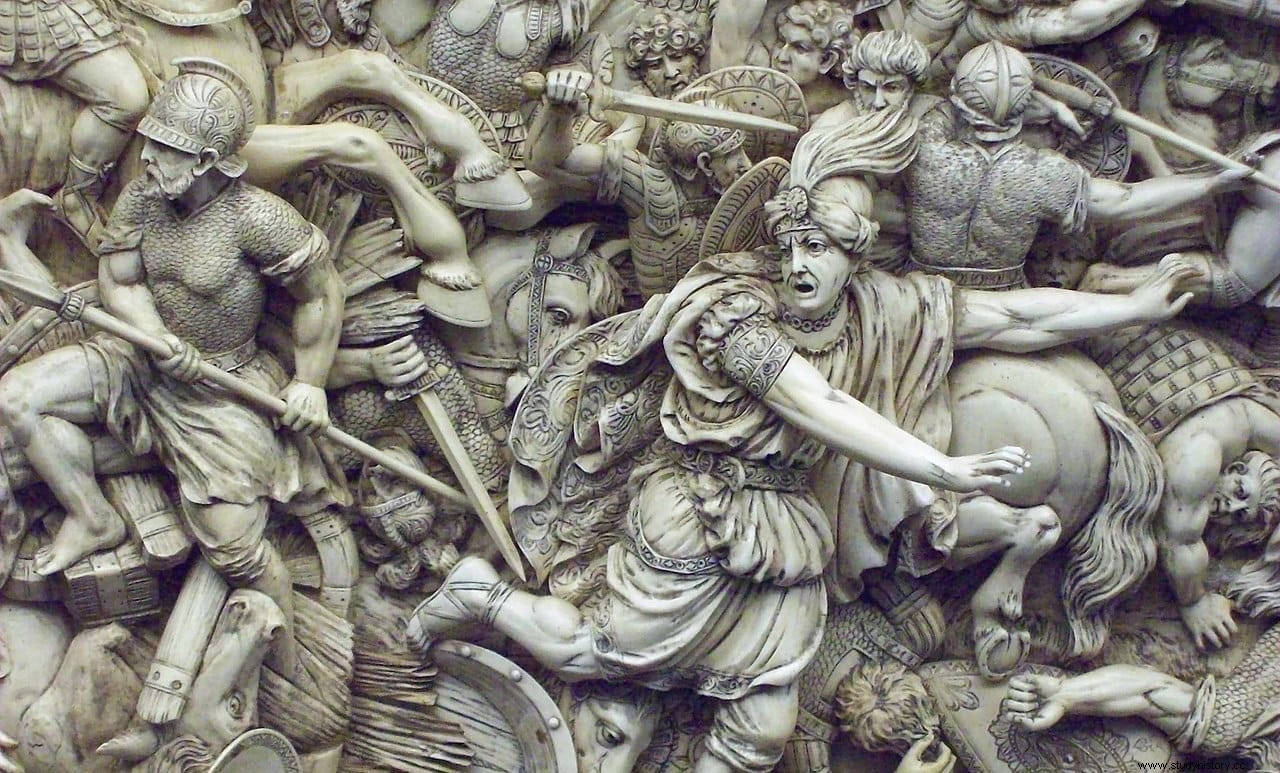
Darius's corpse was mourned by his daughters when it was handed over to them in Persepolis but, according to the Roman historian Quintus Curtius Rufus, author of the Historiae Alexandri Magni Macedonis (ten volumes of which only those dedicated to the war against the Persians are preserved), Sisigambis did not shed a tear for him because he had left her abandoned in Issos, along with the others, and even declared that he only had a son who was king of all Persia, referring to Alexander.
As can be seen, the relationship between the two of her had become almost familiar, to the point that he even called her her mother. That generosity towards her prisoners extended it to the other members of the royal family. Obviously, there was a strategic interest; but as already owner of the empire he could have dispensed with it. Instead, he sent the two princesses to Susa to learn Greek, since their mother Statira had died the previous year (according to one version from illness, according to another from resisting having the child she was expecting because she was no longer to reign).
In the year 324 BC, upon his return from India, Alexandro decreed a macro-ceremony in which a hundred Macedonian officials married as many Persian nobles to link the two peoples. Hephaestion married Dripetis, the youngest daughter of Darius, and Alexander himself married his sister, Barsine. He was already married to the Bactrian Roxana but she was only the daughter of a satrap and the circumstances demanded to take a woman of royal blood, so later he also married a third princess, Parysatis, daughter of Artaxerxes III.
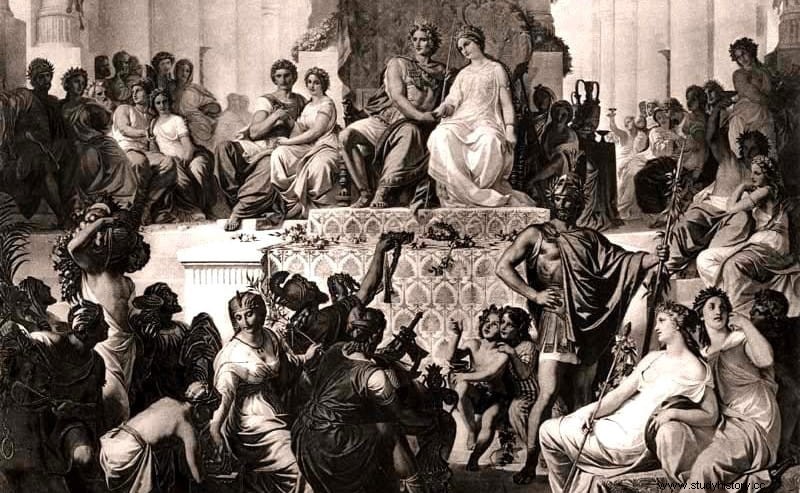
Unfortunately for both, in the year 323 B.C. Malaria took Alexander (or Nile fever, or poisoning...) and Roxana was in charge of dispatching them to ensure the succession of her son, Alexander IV, who had not yet been born, compared to the one Barsine had, Heracles, who he was four years older. Apparently, General Perdiccas was an accomplice to the crime, which also extended to Dipetris because he no longer had protection, having been widowed by Hephaestion a year before Alexander died. Another who lost his life was Oco, the youngest son of Darius, who also constituted a threat in that he was the only direct descendant left to claim the Persian throne.
In 315 BC Roxana would taste her own medicine and, despite the protection that Olympias (Alexander's mother) gave her, she would end up assassinated at the hands of Cassander, son of General Antipater, who seized power in Macedonia in a coup d'état founding the Antipatrida dynasty And Sisigambis? The queen mother again demonstrated how much she had come to appreciate her captor:she was nearly mad with grief upon hearing of Alexander's death and refused to eat, perishing of starvation herself four days later. An asteroid today bears her name.
